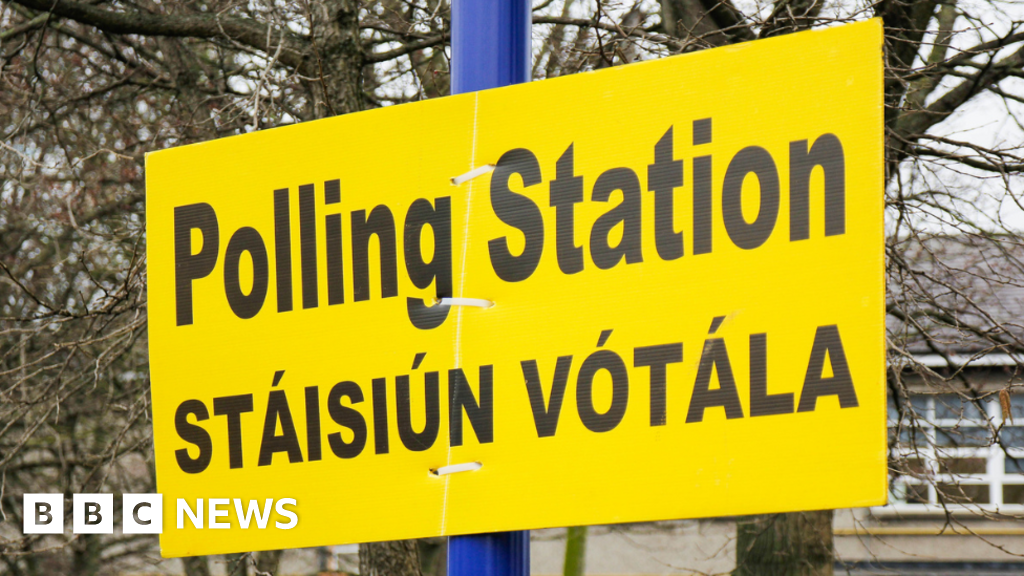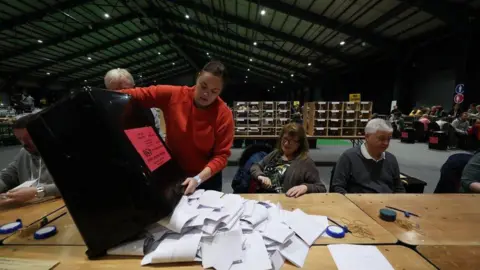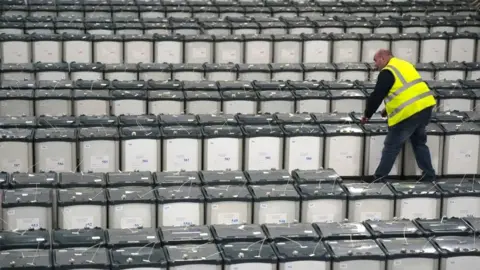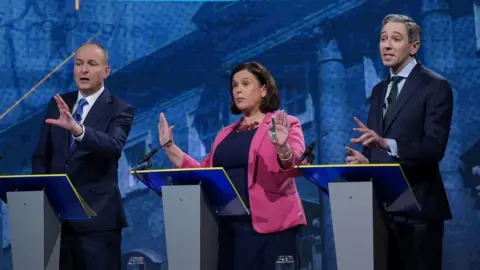
 PA Media
PA MediaThe Irish general election on Friday will decide who will sit in the Dáil, the lower house of the Oireachtas (Ireland’s parliament).
Elected members are known as Teachtaí Dála (TDs).
The number of TDs and constituencies will both increase for the 2024 election after a 2023 review.
There are now 43 Dáil constituencies (up from 39 in 2020) which will elect between three and five TDs each.
A total number of 174 TDs will be selected, up from 160 in 2020.
One seat in the Dáil goes to the Ceann Comhairle (Speaker), so 88 TDs is the number required for an overall majority.
More than 3.4 million people are registered to vote in the Republic of Ireland.
How will votes be counted?
The Republic of Ireland elects its government using a system of proportional representation known as the single transferable vote.
Voters will have the opportunity to rank candidates in their constituency in order of preference, marking their favourite with a number one, a number two beside their next choice and so on.
They can vote for as many or as few candidates as they like.
Candidates will have to reach a certain number of votes in order to be elected.
 PA Media
PA MediaThat number is decided for each constituency using a mathematical formula based on the number of seats available and the number of votes that have been cast.
Counting the ballots takes place in multiple rounds.
Each ballot is initially credited to the first choice.
Once a candidate receives the number of votes required, they are elected and any remaining ballots that are marked with them as first choice are transferred to the second ranked preferences.
Ballots continue to be transferred to the next usable preference until all of the seats in the constituency are filled with candidates who have reached the quota.
What parties are standing in the election?
Politics in the Republic was traditionally dominated by Fianna Fáil and Fine Gael.
Both parties emerged following a split in nationalist opinion over the 1921 Anglo-Irish Treaty.
Fianna Fáil, led by was once seen as more centrist, Fine Gael as more conservative, but differences have blurred and both are now seen as centre-right parties.
Four years ago Fianna Fáil won 38 seats and Fine Gael ended up with 35.
To gain a governing majority, a coalition government was formed between Fianna Fáil, Fine Gael and the Green Party.
 PA Media
PA MediaThis year’s election is the first major electoral test for the Fine Gael leader and outgoing Taoiseach (Irish prime minister) Simon Harris.
He was new to the role in April, when he became the youngest person to lead the Republic of Ireland at 37 after his predecessor Leo Varadkar stepped down.
Harris entered the Dáil in 2011, aged 24, as TD for Wicklow.
He had a rapid rise through the party ranks, landing his first cabinet role before his 30th birthday.
As health minister, he oversaw the Republic’s vote to overturn its abortion ban and was in charge of the country’s initial response to the Covid-19 pandemic.
Fianna Fáil are led by Tánaiste (Irish deputy prime minister) Michéal Martin.
He is a seasoned politician, having left a short-lived teaching career in 1985 to work in politics full-time.
Martin was first elected as a TD in 1989 and has been re-elected in each election since.
He took up the mantel as leader of Fianna Fáil in 2011 and was elected taoiseach in 2020 as part of the three-party coalition agreement.
Sinn Féin, led by Mary Lou McDonald, is an Irish republican and democratic socialist party and the main opposition party.
McDonald was the party’s first MEP (member of the European Parliament) in 2004, and won her first seat for the party in Dáil for the Dublin Central constituency in 2011.
She became vice-president of Sinn Féin in 2009, and took over from Gerry Adams as president in 2018.
Since then, the Dublin politician has sought to distance her party from criticism about its historic links to IRA violence.
In 2020 her party made significant gains and topped the popular vote, winning 37 seats.
Since then it has become the largest party across Northern Ireland‘s councils, as well as in its assembly and at Westminster.
Other parties putting forward candidates for the election include Labour, Social Democrats, PBP-Solidarity, Aontú and the newly-formed Independent Ireland.
What have been the key issues for voters?
How has the election campaign played out?
This campaign has seen its fair share of viral moments.
An awkward encounter between a care worker and Simon Harris while canvassing in County Cork last weekend was viewed millions of times across social media platforms during the last week of the campaign.
In his first campaign as leader of Fine Gael, he is getting plenty of practice trying to put out election fires.
The party has been running its campaign under a “new energy” slogan after his election as leader and Taoiseach earlier this year.
Commentators have been musing over how the ‘Harris Hop’ mave have turned into something resembling a ‘flop’.
Fianna Fáil, on the other hand, have managed to avoid any negative viral moments.
Under the leadership of the outgoing Tánaiste (Irish Deputy-Prime Minister) Micheál Martin, the party has had what’s being referred to as a steady campaign, no big breakthroughs but also no big gaffes.
Sinn Féin has faced questions over its handling of recent internal controversies on both sides of the border, but these events do not appear to have had a particularly significant impact during the campaign as the party’s polling position has recovered marginally.
It has focused on delivering its policy positions around key issues such as its proposed solutions to the country’s housing crisis.
What could a new government look like?
The last poll before the election suggests it’s tight – Fianna Fáil 21%, Fine Gael 20%, Sinn Féin 20%.
The two main parties in the outgoing Irish government have again ruled out Sinn Féin as a potential coalition partner.
Polling also suggests more independent candidates will be elected than in 2020 and if parliamentary arithmetic is tight, their role in government formation could be critical.
If it is to get into government for the first time, it is likely Sinn Féin will have to look to smaller parties or like-minded independents to find the majority.
 PA Media
PA MediaThe first meeting of the new Dáil is on 18 December but it is unlikely coalition negotiations will have finished by then.
Few expect the new government to be in place before 2025.
A government will be officially formed when the Dáil passes a vote to install a new Taoiseach.
When will votes be counted?
Ballot boxes will be sent to the constituency count centre after polls close on Friday but counting will not start until the following morning.
The count can sometimes last several days.




